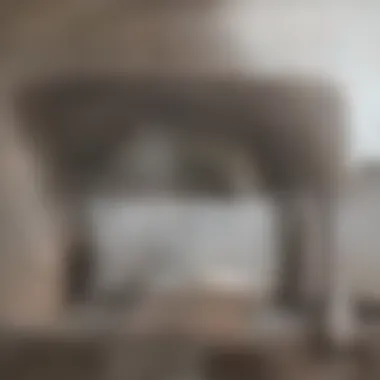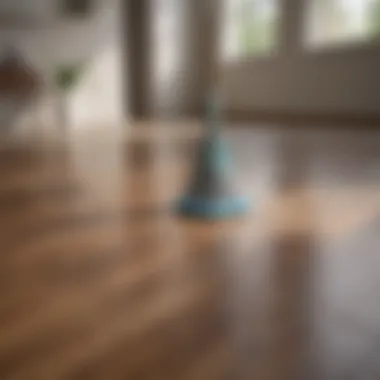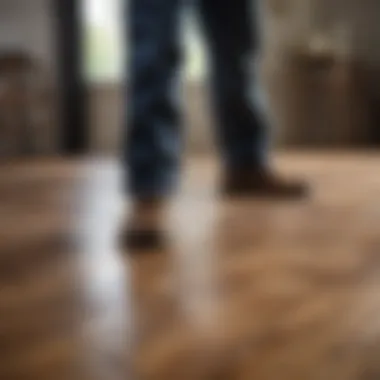Expert Tips for Maintaining Clean Wood Floors


Intro
Maintaining wood floors is a crucial task for homeowners and design enthusiasts alike. Proper care not only enhances the aesthetic appeal but also prolongs the lifespan of the floors. This article delves into essential practices and eco-friendly products for optimal maintenance of wood flooring. Understanding the nuances of cleaning techniques and regular upkeep is vital for achieving clean and sustainable results.
Home Design Inspiration
Architectural Styles
Wood floors complement a range of architectural styles. From traditional to contemporary, wood brings warmth to any setting. For instance, colonial homes often feature oak or maple flooring, while modern designs may utilize bamboo for a sustainable touch. Each wood type has unique characteristics that influence the overall ambiance of a space.
Innovative Decor Trends
In recent years, minimalism and nature-inspired designs have gained traction. Clean wood floors align well with these trends, showcasing simplicity and elegance. Using natural finishes enhances the wood's texture, creating a harmonious blend with interior elements. Incorporating greenery or organic materials can further amplify the beauty of wood flooring, making rooms feel inviting and fresh.
Care Techniques
Caring for wood floors is not just about aesthetics; it involves practical steps to ensure durability. Regular cleaning with gentle cleaners is essential. Avoid harsh chemicals that can damage the finish. A microfiber mop is ideal for removing dust and dirt without causing scratches.
- Dusting: Sweep or vacuum regularly to prevent debris accumulation.
- Spot Cleaning: Wipe spills immediately to prevent stains.
- Deep Cleaning: Use a specialized wood floor cleaner every few months for a thorough cleanse.
The choice of cleaning product matters. Eco-friendly options are widely available. Brands like Bona and Method offer cleaners that are safe for the environment and effective in maintaining wood floors.
"Consistency in maintenance is key to achieving longevity and beauty in wood floors."
Routine Maintenance
Regular maintenance involves more than just cleaning. It includes monitoring humidity levels, as wood can expand and contract. Use a humidifier during dry seasons to maintain optimal conditions.
- Preventive Measures:
- Place rugs in high-traffic areas to minimize wear.
- Use furniture pads to prevent scratches from heavy items.
Seasonal inspections are also beneficial. Check for any signs of damage or wear and address them promptly. This proactive approach ensures that your wood floors remain in excellent condition throughout the year.
Epilogue
Prolusion to Clean Wood Floors
Clean wood floors are more than just an aesthetic choice; they represent a commitment to maintaining a beautiful living space. This section introduces the underlying principles necessary for proper care and maintenance, laying the groundwork for longevity and allure of wood flooring. The maintenance of wooden surfaces not only enhances their visual appeal but also contributes significantly to the overall atmosphere of a home.
Understanding Wood Flooring
Wood flooring comes in diverse types and styles, from solid hardwood to engineered flooring. Solid hardwood is typically made from a single piece of timber, offering durability and a classic look. Engineered wood, on the other hand, consists of multiple layers, making it more stable and less prone to warping in fluctuating humidity and temperature conditions.
Households should evaluate their choices based on lifestyle and aesthetics when selecting wood flooring. Specific wood species, such as oak and maple, exhibit unique grain patterns and colors, which can influence the ambiance of a room. Maintenance varies across types of wood, necessitating knowledge about their respective care requirements. This understanding is crucial for any homeowner to ensure their flooring remains in top condition.
Importance of Clean Wood Floors
Regular cleaning and maintenance of wood floors yield multiple benefits. First, clean surfaces offer a healthier indoor environment, minimizing dust and allergens that can accumulate over time. Additionally, maintaining clean wood floors prolongs their lifespan. Dirt and grit can scratch the surface, leading to the need for more frequent refinishing.
Moreover, visually appealing wood floors enhance the home's market value. Potential buyers often seek spaces that reflect cleanliness and care. A pristine floor can create a positive first impression, influencing purchasing decisions. Beyond the practical aspects, clean wood floors contribute to a welcoming and inviting atmosphere, helping to cultivate a sense of warmth in any home.
Choosing the Right Cleaning Products
Selecting suitable cleaning products is essential for the upkeep of wood floors. The right cleaners can maintain the look and longevity of the wood, while inappropriate choices can cause damage. Understanding different types of cleaners and their components helps in making informed choices that benefit the overall maintenance plan.


Types of Cleaners
Liquid vs. Solid Cleaners
Liquid cleaners are more common for cleaning wood floors. They are easy to use, allowing for quick application and uniform spreads across the floor surface. This can lead to better cleaning coverage. On the other hand, solid cleaners may require more effort to dissolve and apply. One drawback of liquid cleaners is that they can leave excess moisture if not used correctly, potentially harming wood. Solid cleaners often come in a paste or powder form, which can be effective when used on stubborn stains. However, their application could be more labor-intensive compared to liquids. Thus, in most household situations, liquid cleaners are preferable due to their convenience and effectiveness.
Natural vs. Chemical Cleaners
Natural cleaners are derived from safe ingredients like vinegar, baking soda, or plant extracts. They pose fewer health risks and are environmentally friendly. Their effectiveness may vary based on specific cleaning needs. Chemical cleaners often contain enzymes or strong agents meant to tackle tough grime. Their potency can be an advantage, but such cleaners may emit strong odors and contain substances harmful for indoor air quality. It's important to balance effectiveness and safety when choosing between these two types. Homeowners should consider personal preferences and the specific challenges presented by their wood floors before making a choice.
Eco-Friendly Options
Eco-friendly cleaning products are gaining popularity among homeowners who prefer sustainable living. These products often use plant-based ingredients that are less harmful to the environment and human health. Many offers good cleaning power without toxic chemicals. When selecting eco-friendly options, look for certifications and ingredient transparency. Products such as Bona Hardwood Floor Cleaner or Seventh Generation Disinfecting Multi-Surface Cleaner exemplify this trend. They provide solutions that align with the ethos of health and sustainability, making them ideal for maintaining clean wood floors.
Reading Labels
Understanding cleaning product labels is vital. Ingredients can vary significantly among brands, so consumers need to be informed. Look for claims that address specific cleaning challenges related to wood floors. Phrases like "no rinse required" or "safe for sealed surfaces" offer useful insights. Analyzing label claims can prevent choosing products that could potentially harm floors. Moreover, attention to certification logos can guide the decision-making process. Some labels may indicate environmentally friendly claims or hypoallergenic properties that align with personal or family values.
Floor Preparation Before Cleaning
Preparing the floor before cleaning is an essential part of maintaining clean wood floors. This step cannot be overlooked. Proper preparation can not only enhance the effectiveness of the cleaning process but also help in maintaining the floor's condition in the long run. When you remove loose dirt and debris before washing the floor, you prevent scratches and further damage. Removing these unwanted materials makes sure that the cleaning products work better and allows the floor to shine brighter.
Removing Loose Dirt and Debris
The first step in preparation is to remove loose dirt and debris. This step is critical. If dirt is not removed, it may get ground into the wood during the cleaning process. Start by using a broom or a dry mop to catch the larger particles. Sweep the corners of the room carefully, as dirt often collects there. Next, consider using a microfiber cloth to pick up finer dust particles. This will make sure that the floor is cleaned properly. A clean surface is vital for any subsequent cleaning methods used.
Choosing the Right Tools
Selecting the appropriate tools for the job is also very important. Using the right equipment can make the cleaning process easier and more effective. Here are two common tools for cleaning wood floors:
Mops and Brooms
Using mops and brooms can simplify the process of removing loose dirt. Brooms are great for sweeping up large debris. They can pick up dirt, hair, and other particles quickly. A good-quality broom should have soft bristles that do not scratch the floor. On the other hand, mops are essential for light dusting and wet cleaning. They can easily cover larger areas in shorter times. Different types of mops exist, such as microfiber mops that are popular because they can attract and hold dirt very well. Their unique feature is their ability to clean effectively without the need for harsh chemicals.
Vacuum Cleaners
Vacuum cleaners also play a significant role in floor preparation. Using a vacuum can be more effective than a broom, especially for homes with pets. A vacuum cleaner designed for hardwood can prevent scratches. Its key characteristic is the absence of a rotating brush which could damage the wood. Some models have attachments for corners which can be helpful for reaching those hard-to-reach areas in your home. A disadvantage might be bulkiness, but the advantages of efficient dirt removal often outweigh the cons. Overall, these tools allow for a thorough cleaning preparation, setting the stage for the actual cleaning process that follows.
Cleaning Techniques for Wood Floors
Cleaning techniques play a crucial role in maintaining the appearance and longevity of wood floors. Proper cleaning not only enhances the aesthetic value of your flooring but also extends its life by preventing dirt and grime buildup that can lead to surface damage. Additionally, using the right techniques can help in preserving the natural beauty and finish of the wood, ensuring that the floors remain a focal point in your home for years to come.
Dry Cleaning Methods
Dry cleaning methods refer to techniques that do not involve the use of water or cleaning liquids. These methods are highly effective for daily upkeep, as they remove loose dirt and dust that settle on the floor. Vacuuming is one of the most popular dry cleaning techniques. A vacuum cleaner designed specifically for wood floors prevents scratches and collects debris efficiently.
Other useful dry cleaning tools include microfiber mops and brooms. Microfiber mops trap dust and dirt without leaving streaks, making them a beneficial choice. Regular use of these methods minimizes the amount of moisture that can affect wood floors, reducing the risk of warping or swelling.
Wet Cleaning Methods
Wet cleaning methods are essential for deeper cleaning, eliminating stains, and restoring shine to wood floors. However, wet cleaning requires careful execution to prevent damage.
Using Mops
Using mops is a common practice in wet cleaning. A damp mop can effectively pick up stubborn dirt while preventing excessive moisture from seeping into the wood. Its ease of use makes it a popular choice for homeowners. The key characteristic of a mop is its ability to cover large areas quickly, making cleaning more efficient.
A unique feature of mops designed for wood floors is their use of soft, absorbent materials that prevent scratching. However, one disadvantage is that improper use of mop water can leave streaks or unintentional moisture damage.\n


Using Cloths
Using cloths is another method in the wet cleaning repertoire. Microfiber cloths, in particular, are advantageous due to their particle-trapping capability. They are suitable for detailed cleaning, especially in corners and around furniture. The primary characteristic of cloths is their versatility; they can be used for spot cleaning as well as whole-floor maintenance.
The unique advantage of cloths is their ability to apply cleaning solutions more precisely than mops. However, they may require more physical effort and time, especially for larger areas. Choosing the right cleaning solution for cloths is essential to avoid residue formation that can dull wood surfaces.
Spot Cleaning for Stains
Spot cleaning is crucial for addressing stains promptly before they become permanent. Identifying the type of stain can guide the cleaning method. For example, water-based stains may respond well to a damp cloth, while oils might require specific cleaning solutions tailored for grease.
For effective spot cleaning, always act quickly. Blot the stain with a soft cloth instead of rubbing, as rubbing can spread the stain further. This technique not only removes the stain but also minimizes potential damage to the wood's finish.
Post-Cleaning Maintenance
Post-cleaning maintenance is a crucial phase in the caring for wood floors. It ensures that the floor maintains its aesthetic appeal and durability over time. Negligence during this stage can lead to a deterioration of the wood, which is often costly to rectify. Thus, understanding the necessary steps and their benefits plays a vital role in preserving the quality of wood flooring.
One of the primary benefits of post-cleaning maintenance is that it helps to prevent moisture damage. Wood is an organic material, and exposure to excessive moisture can lead to warping and mold growth. When the cleaning process is completed, allowing the floor to dry effectively is essential to mitigate these risks. Proper attention to drying routines prepares the surface for subsequent treatments and offers a longer lifespan to the flooring.
Drying the Floors
Drying the floors after cleaning requires careful consideration. Ideally, the drying process should be gradual. Using fans or dehumidifiers can significantly speed up moisture evaporation. However, avoid excessive airflow directly onto the surface, as this could cause uneven drying and potentially damage the wood.
You might consider the following techniques:
- Ventilation: Open windows to allow fresh air circulation.
- Use Fans: Position them to enhance airflow without directing strong gusts on the surface.
- Avoid Sunlight: Direct sunlight, while beneficial for drying, can cause the wood to change color over time.
Monitoring the humidity levels in the environment can also guide the drying process. An optimal humidity range is between 30% and 50%. This balance helps prevent both mold growth and wood shrinkage.
Applying Conditioning Products
Once the floor is dry, applying conditioning products is often recommended. These products are essential for restoring the wood’s natural oils, which can be depleted during cleaning. Conditioning helps maintain the sheen of the wood and provides a protective layer that guards against future spills and stains.
When selecting conditioning products, consider the following:
- Wood Type Compatibility: Ensure the product is suitable for your specific type of wood, as each species may react differently.
- Application Method: Some products may require buffing or application with a cloth, while others are suitable for spraying. Following the manufacturer's instructions is critical for achieving the desired results.
Remember, conditioning should not be a one-time task. Regular application helps prolong the life of your wood floors. Proper post-cleaning practices not only enhance the visual appeal but also contribute to the overall health of the flooring.
"Neglecting post-cleaning maintenance can lead to premature wear and costly repairs, making it an essential element in the care of wood floors."
In summary, post-cleaning maintenance is more than just a formality; it is a strategic approach that emphasizes protection and longevity for wooden floors. As such, integrating drying techniques and conditioning products into your maintenance routine is vital for achieving optimal results.
Preventing Damage to Wood Floors
When it comes to maintaining clean wood floors, preventing damage is a pivotal aspect that can prolong their lifespan and aesthetic appeal. Wood floors are often one of the most significant investments in a home, and neglecting proper care can lead to irreversible harm. There are various elements that can cause damage, such as dirt, moisture, and excessive wear from foot traffic. Thus, understanding how to protect these surfaces is essential for every homeowner.
Ensuring the longevity of wood floors is not only about cleaning; it also involves implementing strategies to minimize potential harm. Here are key considerations:
- Cost-effective Maintenance: Preventing damage reduces the need for extensive repairs or replacements, which can be costly over time.
- Aesthetic Value: Well-maintained wood floors enhance the beauty of a home, adding warmth and character.
- Health Benefits: Eliminating scratches and dents helps maintain a smoother surface, reducing the accumulation of dirt and allergens.
Overall, investing time and resources into preventive measures will yield substantial benefits.
Using Mats and Runners
One of the simplest ways to prevent damage to wood floors is by incorporating mats and runners in high-traffic areas. These accessories shield the floor from scratches, scuffs, and dirt tracked indoors. By strategically placing mats at entrances and along hallways, homeowners can effectively minimize the wear and tear that occurs with regular foot traffic. Here are some practical tips:


- Selection of Mats: Choose mats that have a non-slip backing to prevent them from sliding, which can also cause damage.
- Regular Cleaning: Ensure mats are cleaned frequently to avoid the buildup of dirt and debris that can end up on the wood floors.
- Floor Compatibility: Opt for mats and runners made from materials that are safe for wood floors, as certain rubber backings may cause discoloration.
With these measures in place, mats and runners can significantly contribute to maintaining the integrity of the flooring.
Managing Pet and Foot Traffic
Domesticated animals and visitors are common sources of wear and tear on wood floors. Managing pet and foot traffic effectively can greatly decrease potential damage. Here are several strategies to protect your wood flooring:
- Pet Training: Train pets to use designated areas and consider using pet-friendly barriers to limit access to certain rooms.
- Paw Care: Keep your pets' claws trimmed to reduce scratches. Regular grooming can help minimize shedding and dirt accumulation.
- Footwear Policies: Encourage family and guests to remove shoes upon entering to reduce dirt and minimize abrasive materials coming into contact with the floor.
By adopting these practices, homeowners can dramatically reduce the risk of scratches and dents caused by pets and foot traffic.
"Prevention is key. Simple measures can save costly repairs in the long run."
Long-Term Care Strategies
Long-term care strategies are essential for preserving the beauty and longevity of wood floors. These strategies involve proactive measures that go beyond routine cleaning, ensuring that your floors remain in optimal condition for years to come. Prioritizing these care methods not only enhances the aesthetic appeal but also increases the overall value of your home.
A consistent approach allows for the identification of issues before they become significant problems. By committing to a structured care regime, homeowners can protect their investment and save on costly repairs down the line. This section outlines two crucial aspects of long-term care strategies: periodic deep cleaning and surface refinishing options.
Periodical Deep Cleaning
Periodical deep cleaning is a fundamental aspect of maintaining clean wood floors. Despite regular cleaning, dirt and grime can accumulate over time. Deep cleaning ensures that these contaminants are effectively removed, allowing the floor to breathe and maintain its natural luster. Ideally, deep cleaning should be performed every six months or as needed, depending on traffic levels and exposure to dirt.
The deep cleaning process typically involves the following steps:
- Preparation: Clear the area of furniture and items to access the entire floor.
- Sweep or Vacuum: Remove loose dirt and debris to prevent scratching during the deep clean.
- Appropriate Cleaning Solution: Use a cleaner specifically formulated for your type of wood. It’s crucial to avoid excessive moisture.
- Damp Mop: Using a damp mop, carefully clean the floor without saturating it. Ensure the mop head is clean to avoid redistributing dirt.
- Drying: Allow the floor to completely dry afterward, which helps prevent moisture damage and warping.
By establishing a routine for periodic deep cleaning, you can restore the finish of your floors and keep them looking their best.
Surface Refinishing Options
Over time, even the most well-maintained wood floors may show signs of wear. Surface refinishing is a key component of longer-term care strategies. This process revitalizes the wood surface and can be done without the need for complete replacement. Different refinishing options exist, each catering to specific needs and preferences.
- Screening and Coating: This option involves scuffing the surface with a fine abrasive pad and applying a new layer of finish. It’s less invasive and can be completed in a single day.
- Sanding and Refinishing: This method removes old finish layers and repairs damage by sanding down to the raw wood. It is more intensive and may require several days, but offers a fresh start for heavily worn floors.
- Finish Options: After sanding, homeowners can choose between oil-based or water-based finishes. Oil-based finishes tend to be more durable but take longer to dry, while water-based options provide quicker drying times and minimal odor.
When deciding on a refinishing option, consider the level of wear your floors have sustained, as well as your personal aesthetic preferences. Surfacing refinishing, when combined with periodic deep cleanings, results in a comprehensive strategy for maintaining the integrity and beauty of wood floors.
"A well-maintained wooden floor not only enhances interior aesthetics but also significantly increases property value."
The End
Maintaining clean wood floors is essential for their longevity and aesthetic appeal. This article highlights the critical importance of optimal care and maintenance routines. It emphasizes several specific elements such as choosing the right products, using appropriate cleaning techniques, and implementing preventive measures.
By following best practices outlined in this guide, homeowners can keep their wood floors looking pristine while also extending their lifespan. A consistent cleaning routine not only enhances the appearance of the floors but also supports a healthy living environment, free from allergens and dirt.
Recap of Best Practices
To summarize the best practices for maintaining clean wood floors:
- Regular Sweeping and Dusting: Eliminate dirt and debris to prevent scratches.
- Use Recommended Cleaners: Select products suitable for wood surfaces to avoid damage.
- Opt for Soft Tools: Use microfiber mops and soft cloths to avoid abrasive damage.
- Establish a Routine: Regular cleaning prevents buildup and maintains floor shine.
- Preventative Measures: Ensure the use of mats at entrances and manage foot traffic.
Ensuring cleanliness and maintenance of wood floors not only preserves their beauty but also enhances the value of your property.
By implementing these measures, homeowners can easily manage their wood floors, ensuring they remain an investment that appreciates in aesthetic value over time.
Emphasizing Sustainability
In today's world, sustainability plays a vital role in every aspect of home maintenance. Choosing eco-friendly products is not only better for the environment but also safer for the home. Many chemical cleaners can release volatile organic compounds (VOCs), which can be harmful to health.
When maintaining wood floors:
- Select Natural Cleaners: Look for brands that offer plant-based or natural cleaning solutions.
- Reduce Waste: Implement reusables such as washable cleaning pads instead of disposable ones.
- Conserve Resources: Use water and energy efficiently during cleaning routines.
- Seek Sustainable Products: Research brands that focus on sustainable sourcing of their materials.







